Embryology Biology 441 Spring 2014 Albert Harris
Introduction to Chromatin
Guest lecture by Taylor Penke
What is chromatin?
Chromatin- DNA and any associated proteinsNucleosome- basic unit of chromatin. It consists of DNA wrapped around a histone ocatamer
-
Histone- positively charged proteins that bind DNA
What is the function of chromatin?
Chromatin allows DNA to be compacted within the nucleus
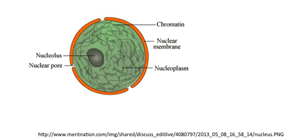
There are several layers of compaction of DNA.
1) DNA wrapped around histones to form "beads on a string" structure
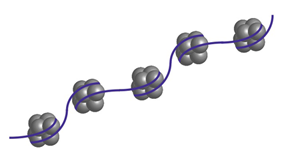

2) Other layers of compaction are not well understood but are thought to involve interactions among neighboring histones and further coiling of the "beads on a string" structure
link to video shown in the lecture
Chromatin must be regulated to allow various cellular machineries to access the DNA. For example, DNA must be replicated, transcribed etc. and these processes cannot occur if DNA is compacted too much.
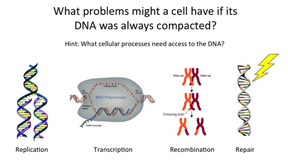
There are therefore different types of chromatin
-
Euchromatin- more accessible chromatin which tends to be more transcriptionally active
Heterochromatin- condensed chromatin which tends to be a repressive environment
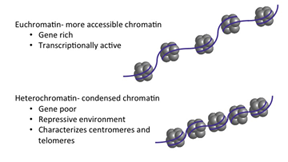
How do cells regulate chromatin compaction?

Epigenetic modifications
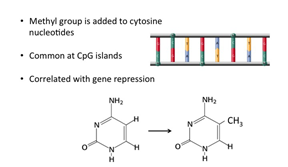
-
DNA Methylation
- Methyl group added to cytosine nucleotides
- Correlated with gene repression
- Histone proteins have "tails" which are an unstructured region of amino acids
- Amino acids on these tails can be modified. Different groups such as methyl, acetyl, and phosphate can be attached to these amino acids
- These modifications affect the level of chromatin compaction in two ways
- Chromatin remodelers- proteins that move nucleosomes around and can influence the level of compaction
-
1) Alter the charge interaction between DNA and histones- making the histones more negatively charged will diminish the strength of interaction with negatively charged DNA
2) Modifications can serve as binding sites for chromatin remodelers
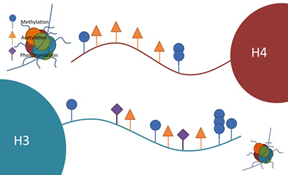


Chromatin and Development
Correct gene expression is essential for cells to differentiate into the necessary cell type.

- Correct differentiation of cells requires expression of the right genes at the right time while keeping other genes off
- Chromatin can help control this differential gene expression!

Different histone modifications can recruit either transcriptional activators or repressors

- Modifications associated with activation
- Acetylation
- H3K4me
- H3K79me
-
Modifications associated with repression
- H3K9me2, H3K9me3
- H3K27me2, H3K27me3
- H4K20me2, H4K20me3
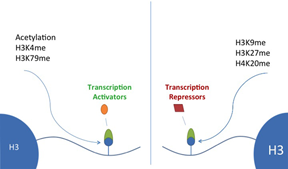
Chromatin helps regulate Hox gene expression
- Trithorax proteins- activating
- H3K4 methylases
- Chromatin remodelers
- H3K27 demethylases
- Histone acetylases
- Polycomb proteins- repressing
- H3K27 methylases
- H3K4 demethylases
- Histone deacetylases
- These proteins act on Hox genes to maintain their active or silent state
- These proteins are targeted to different Hox genes in different cells
- How might they be differentially targeted?
- How might chromatin explain colinearity?
